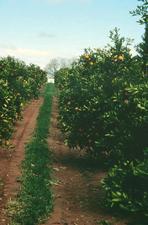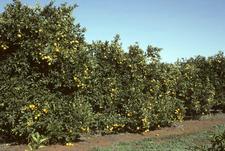Dwarfing Citrus Trees by Viroids
HISTORY, DISTRIBUTION AND IMPORTANCE
Graft transmissible dwarfing (GTD) of citrus trees on Poncirus trifoliata rootstock, in the absence of scaling symptoms of the stock, was described by Fraser et al. (1961). Long et al. (1972) recognized the possibility of greater yields per hectare through the close planting of ‘virus’- dwarfed orange trees. Viroids were associated with symptoms of graft transmissible dwarfing (Schwinghamer & Broadbent, 1987) and specific viroids were found in dwarfing isolates used in horticultural trials in Australia (Gillings et al. 1991) and Israel (Bar-Joseph, 1993).
Viroids causing dwarfing on P. trifoliata and its hybrids occur in all major citrus growing regions.
The benefits of using viroids for tree size control without affecting cropping efficiency or fruit quality are dependent on close planting of trees (GTD. 01) have been reviewed (Bar-Joseph, 1993; Hutton et al., 2000; Semancik, 2003) and include ease of harvesting and tree care, economies of fertilizer and irrigation, early productivity and quickened supply of new varieties. Despite these advantages, the only country to plant significant areas of viroid-dwarfed trees has been Israel. In Australia (GTD. 02), only 115,000 ‘dwarfing’ buds were sold from 2003-2006 (principally for use on Valencia orange for processing, where a mechanical harvester is to be used) and no GTD buds have been sold in California. Roistacher (1992) cited a number of reasons for his concerns about the use of viroids for tree size control: potential for mutations, mechanical transmissibility, heightened susceptibility of viroid infected trees to frost, potentially deleterious effects from the indiscriminate use of viroids by nurserymen. Bar-Joseph (pers.comm.) now considers that the use of GTD is incompatible with the operations of a high health status budwood scheme.
It has become obvious that GTD has benefits while conditions for tree growth and management are optimal, but any stress on trees (eg drought, salinity) will have a greater adverse effect on GTD-inoculated trees than their viroid-free counterparts (Bar-Joseph and Broadbent, pers.comm.).
NAME OF “DISEASE” AND SYNONYMS
Viroid dwarfing and graft transmissible dwarfing.
Abbreviation: GTD (graft transmissible dwarfing)
SYMPTOMATOLOGY
General aspect of affected field tree
Reduced trunk growth on GTD inoculated trees [natural isolates of Citrus viroid III- CVd-III(variant CVd-IIIb) +/- Hop stunt viroid- HSVd(variant CVd-IIa)] becomes apparent two years after planting and effect on canopy size measurements is evident after 5 years for orange trees on P. trifoliata rootstock (GTD. 03) (Bevington and Bacon, 1977, Hutton, 2006).
Timing of growth flushes is not affected by GTD inoculation. There is less total vegetative shoot growth and significantly less total spring vegetative growth in GTD than in non-inoculated trees with less mean spring flush shoot number and mean total shoot length developed in spring, consistent with the smaller annual increment in trunk cross-sectional area (TCSA) and tree height. No significant differences in the number and length of vegetative shoots developed during the summer and autumn flushes.
Morphology of autumn shoot growth is different, with more shoots of smaller internode length and fewer leaves developing on GTD trees than on non-inoculated trees whose autumn growth was sparse and appeared as rank water shoot growth in the top half of the tree canopy (Hutton et al., 2000; Hutton, 2006).
Symptoms on trunk
In trees grafted on P. trifoliata, dwarfed with natural viroid isolates often containing more than one viroid and in the absence of CEV butt scaling, the stock is broader than the scion trunk and often predominantly shouldered or benched at the bud union, in contrast to non-inoculated trees in which the stock is fluted and evenly expanding from the bud union to the crown roots (GTD. 04). The bark of the stocks of viroid-dwarfed trees varies from smooth, sometimes with “tessellation” to thin flaky bud scales or persistent corky pustules arranged singly or grouped or in horizontal bands and some trees with an indented ring at the bud union, visible when the bark was removed (Fraser and Broadbent, 1979).
The P. trifoliata rootstocks of GTD inoculated trial trees (natural variants CVd-IIIb +/- CVd-IIa) in Australia were smooth, although benched.
In Valencia orange on P. trifoliata, Roistacher et al., (1993) reported deep pits with corresponding pegs in the bark for Citrus bent leaf viroid – CBLVd (variant CVd-Ia), mild bark cracks for CVd-IIa and finger imprint and bark striations for CVd-IIIb.
Trifoliate orange seedlings and rootstocks infected with three different variants of HSVd (variants CVd-IIa, CVd-IIb and CVd-IIc) (Vernière et al., 2002) and Citrus viroid IV - CVd-IV (Vernière et al., 2006) showed characteristic bark cracks. CLBVd and CVd-III did not produce bark symptoms (Vernière et al., 2006).
Symptoms on fruit
Yields of viroid (CVd-IIIb +/- CVd-IIa) inoculated trees are reduced directly in proportion to the reduction in canopy surface area, but production at orchard level is increased where there is a higher planting density (trees/ha). Relationships between dwarfing and the effects of tree spacing on productivity have been investigated (Hutton and Cullis, 1981; Hutton, 1986). A factor contributing to the higher yield efficiency of GTD inoculated trees was their denser canopy structure, which contributed to a greater number of potential fruit bearing sites relative to tree size (TCSA).
GTD inoculation has no effect on the timing, duration and intensity of flower production, patterns of fruit development and final fruit size at harvest, internal fruit juice quality characteristics. As GTD trees produced a higher yield/ha, less water was used to produce every kg of fruit in GTD trees than in non-inoculated trees (Hutton, 2006).
CAUSAL AGENTS: DESCRIPTION AND PROPERTIES
Gillings et al. (1991) found that all GTD isolates in Australia carry variant CVd-IIIa of CVd-III, sometimes in the presence of variant CVd-IIa of HSVd. Rakowski et al. (1994) demonstrated that CVd-IIIa variants present 99.3% sequence identity with the type member of CVd-III i.e. CVd-IIIb variant.
In a study of the effect of individual viroids, Vernière et al., (2006) found that the reduction in tree size and fruit yield occurred mainly in trees infected with the two apscaviroids CVd-III and to a lesser extent with CBLVd.
HOST RANGE
All Citrus spp. are susceptible to the citrus dwarfing viroids, but only Poncirus trifoliata and its hybrids (eg citranges) and Rangpur lime give a dwarfing response.
TRANSMISSION
- No evidence for vector or seed transmission.
- Viroids are bud or graft transmitted and can be mechanically transmitted.
- Inoculation of trees during their first year in the field is recommended to avoid mechanical transmission of viroids in the nursery (Hutton et al., 2000).
SELECTED REFERENCES
Bar-Joseph, M. (1993). Citrus viroids and citrus dwarfing in Israel. Acta Hort. 349: 271-276.
Bevington, K.B., P.E. Bacon (1977). Effects of rootstocks on the response of navel orange trees to dwarfing inoculations. Proc. Int. Soc. Citriculture, 2: 567-570.
Duran-Vila, N., C.N. Roistacher, R. Rivera-Bustamante, J.S. Semancik (1988). A definition of citrus viroid groups and their relationship to the exocortis disease. J. Gen. Virol. 69:3069-3080.
Fraser, L.R., P. Broadbent (1979). Virus and related diseases of citrus in New South Wales. NSW Department of Agriculture. Surrey Beatty & Sons Pty. Ltd., Chipping Norton.
Fraser, L.R., E.C. Levitt, J.E. Cox (1961). Relationship between exocortis and stunting of citrus varieties on Poncirus trifoliata rootstock. p. 34-39. In W. C. Price (ed.) Proc. 2nd Conf. Intern. Organization Citrus Virol., Univ. Florida Press, Gainesville.
Gillings, M.R., P. Broadbent, B.I. Gollnow, C. Lakeland (1991). Viroids in Australian citrus. Australian J. Plant Physiology 18: 559-570.
Hutton, R.J. (1986). The influence of tree size control and plant density on citrus productivity. (In "Physiology of Tree Fruits"). Acta Horticulturae 175: 249-254.
Hutton, R.J. (2004). Effects of cultural management and different irrigation regimes on tree growth, production, fruit quality and water relations of sweet orange (Citrus sinensis (L.) Osbeck). Ph. D Thesis, University of Sydney.
Hutton, R., P. Broadbent, K. Bevington (2000). Viroid dwarfing for high density plantings. Horticultural Reviews 24: 277-317.
Hutton, R.J., B.R. Cullis (1981). Tree spacing effects on productivity of high density dwarf orange trees. Proc. Int. Soc. Citriculture, 1, 186-190.
Long, J.K., L.R. Fraser, J.E. Cox (1972). Possible value of close planted, virus dwarfed orange trees. p. 262-267. In: Price WC (ed.) Proc. 5th Proc. Int. Organization Citrus Virol. Gainesville: University of Florida Press.
Rakowski, A., J.A. Szychowski, Z.S. Avena, J.S. Semancik (1994). Nucleotide sequence and structural features of the group III citrus viroids. J. Gen. Virology 75: 3581-3584.
Roistacher, C.N. (1992). Dwarfing of citrus by use of viroids: pros and cons. Proc. Int. Soc. Citriculture 3: 791-796.
Roistacher, C.N., J.A. Bash, J.S. Semancik (1993). Distinct disease symptoms in Poncirus trifoliata indusced by three citrus viroids from three specific groups. In: P. Moreno, J.V. da Graca and L.W. Timmer (eds.) Proc. 12th Conf. Int. Organization Citrus Virol., IOCV, University of California, Riverside.
Schwinghamer, M.W., P. Broadbent (1987). Association of viroids with graft transmissible dwarfing symptoms in Australian orange trees. Phytopathology 77: 205-207.
Semancik, J.S. (2003). Considerations for the introduction of viroids for economic advantage. P. 357-362. In A. Hadidi, R. Flores, J. Randles, J.S. Semancik (eds.) Viroids. Science Pub Inc CSIRO, Australia.
Vernière, C., L. Botella, A. Dubois, C. Chabrier, N. Duran-Vila (2002). Properties of citrus viroids: symptom expression and dwarfing. p. 240- 248. In: N. Duran-Vila, R. G. Milne, J. V. da Graça (eds) Proc. 15th Conf. Int. Organization Citrus Virol. International Organization of Citrus Virologists, University of California: Riverside.
Vernière, C., X. Perrier, C. Dubois, A. Dubois, L. Botella, C. Chabrier, J.M. Bovè, N. Duran-Vila (2002). Interactions between citrus viroids affect symptom expression and field performance of Clementine trees grafted on trifoliate orange. Phytopathology 96: 356-368.
Prepared (2007) by Patricia (Broadbent) Barkley1 and R.J. Hutton 2
1 Australian Citrus Growers’ Inc.,
Mildura
Australia
2 New South Wales Department of Primary Industries
Wagga Wagga, NSW
Australia.
Click any image to see it larger.
PHOTOS |
LEGENDS AND AUTHORS |
|---|---|
|
Aerial photograph of 7 year old Valencia orange trees on Poncirus trifoliata showing differences in canopy surface area developed at higher tree densities. From the top of the photo blocks 1,4 and 6 are uninoculated trees at 664 trees /ha, blocks 3,5 and 7 are dwarfed with viroids CVd-IIIa + CVd-IIa at 2127 trees/ha while blocks 2 and 4 are the same inoculation at 1000 trees/ha. NSW DPI - R. Hutton
|
|
|
A commercial block of Washington navel oranges on Poncirus trifoliata inoculated in the field one year after planting with CVd-IIIa, growing at Leeton, NSW Australia. NSW DPI - P. Broadbent
|
|
|
Valencia orange trees on Poncirus trifoliata rootstock from left of photo are 1. uninoculated, 2. dwarfed with CVd-IIIa and 3. dwarfed by Citrus Exocortis Viroid. Note differences in tree height. - P. Broadbent
|
|
|
A. Bark scaling of Poncirus trifoliata rootstock caused by Citrus Exocortis Viroid. B. “Tessellation” and minor bark scaling on Poncirus trifoliata rootstock caused by CVd-IIIa. C. A healthy Poncirus trifoliata rootstock under a sweet orange scion. NSW DPI - P. Broadbent
|




